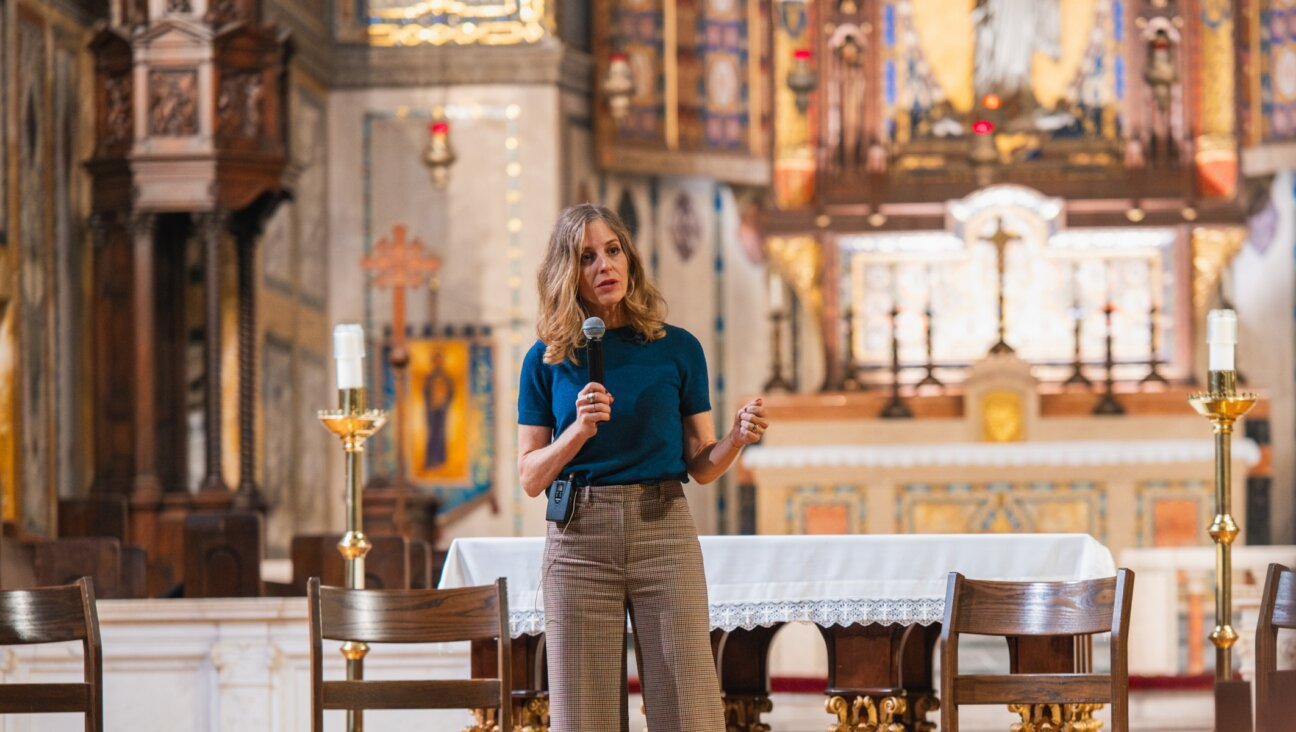Dance the Night Away

Illustration by Kurt Hoffman
Over the past few years, some congregations in New York City have put a new spin on the old song “Dancing in the Street” as they celebrate Simchat Torah, the annual completion and recommencement of the cycle of reading the Torah. The festival, which this year begins October 4 at sundown, is observed amid much rejoicing, singing and dancing, as congregations carry all their Torah scrolls around the sanctuary in a festive parade of seven circuits, or hakafot. Afterward, the same congregations do a seamless reading from the last verses of Deuteronomy to the first verses of Genesis, a visible demonstration that the reading of Torah is literally never ending.

Illustration by Kurt Hoffman
On the Upper West Side of Manhattan, Simchat Torah celebrations are well known, with Jews dancing their way across town at various synagogues. Some of the parties are held outside on the street, while others, for various reasons, remain indoors.
One of the best-known celebrations in that neighborhood is that of Congregation B’nai Jeshurun, where the congregants’ year-round lively dancing and musical accompaniment all seem tailor-made for the holiday.
B’nai Jeshurun’s Rabbi J. Rolando Matalon said that his synagogue started the tradition of outdoor dancing on West End Avenue in the mid-1990s as an issue not of simcha, per se, but rather of space.
“At the time, we didn’t have the synagogue on 88th Street due to repairs,” Matalon wrote in an e-mail to the Forward. During construction, the congregation utilized the Church of St. Paul and St. Andrew, at 86th Street and West End Avenue, as an alternate service space. “Dancing at the church was very difficult with so many people, so we went outside.”
Taking it outside, it turned out, ramped up Simchat Torah to a whole new level. The synagogue brought out its world-renowned musicians and, with a permit from the city, cordoned off West End Avenue from 86th to 87th Streets, allowing hundreds of Jews to celebrate in the street.
It was originally intended to be a celebration for BJ congregants, but the event quickly developed into the Simchat Torah “happening” of the Upper West Side, with Jews from all affiliations and denominations stopping by to sing, dance and meet people.
But after the events of September 11, 2001, the police did not give the synagogue permission to cordon off the street. According to Matalon, officials said that they had no way of properly securing the event. The last of BJ’s outdoor Simchat Torah celebrations was held in 2000.
“So, we went inside at the synagogue, and found out that it was much better for dancing,” Matalon said. “Outside was nice, but there was a lot of talking and socializing and not enough singing and dancing. It became more of a community happening and less of a true Simchat Torah spiritual experience.”
“Some were disappointed in the beginning,” he added. “But it soon became clear that we can have a better Simchat Torah inside.”
Many Upper West Side Jewish residents, however, speculated that concern over security might not be the only reason for ending BJ’s outdoor celebrations.
One Orthodox man, who asked to remain anonymous, said that he could certainly see the merit in arguments about the security of the event.
“Even before 9/11, it was such a target-rich environment,” he said. “Lots of people felt that it was under-protected and too dangerous — myself included — and no one wanted to take responsibility for protecting the crowd. It was too risky a proposition.”
But he conjectured that the “happening” quality of BJ’s outdoor celebration might have sparked dissent among the Upper West Side community, as well. “I don’t think that the Orthodox rabbis were happy that their congregants were mixing with the other, non-Orthodox shuls, especially BJ, with the live music, mixed dancing and women holding Sefer Torahs,” he said.
Today, New York City’s prevalent outdoor Simchat Torah celebration, perhaps in response to such concerns, is that of West Side Institutional Synagogue on West 76th Street, an Orthodox congregation that advertises its celebration as being “from dusk till dawn.”
“There is definitely a Simchat Torah ‘circuit,’” said Jeremy Feinstein, a Conservative Jew who lives on the Upper West Side. “I like to walk around to see the different Upper West Side synagogues, starting with BJ, which I think is the best, and then Shaare Zedek. It’s good to conclude the evening at the outdoor celebration on 76th. I would not spend the whole night there, since it is fairly Orthodox, with a mix of others who are cruising around, like me.”
As to whether BJ’s outdoor Simchat Torah happening will ever be revived, Matalon said that it is “not in our plans for the moment.”
Jordana Horn is a lawyer at work on her first novel.
A message from our Publisher & CEO Rachel Fishman Feddersen

I hope you appreciated this article. Before you go, I’d like to ask you to please support the Forward’s award-winning, nonprofit journalism during this critical time.
We’ve set a goal to raise $260,000 by December 31. That’s an ambitious goal, but one that will give us the resources we need to invest in the high quality news, opinion, analysis and cultural coverage that isn’t available anywhere else.
If you feel inspired to make an impact, now is the time to give something back. Join us as a member at your most generous level.
— Rachel Fishman Feddersen, Publisher and CEO























